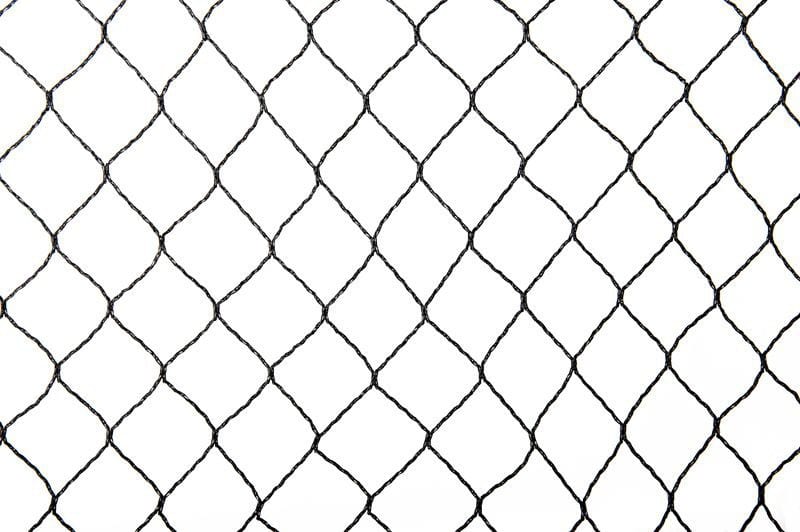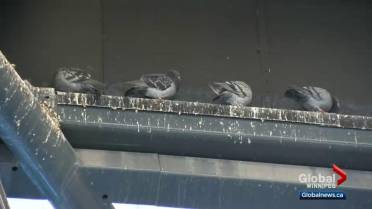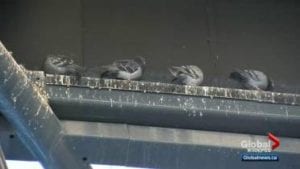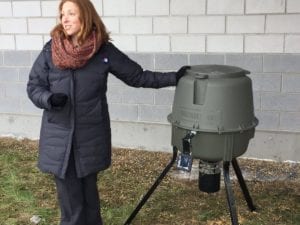
by Pigeon Patrol | Feb 9, 2021 | Animal Deterrent Products, Bird Deterrent Products, Bird Netting, Columbidae, Doves, Pigeon Predators, Pigeons
Pigeon Patrol Bird Netting
BUY HERE : https://www.pigeonpatrol.ca/product/mesh-bird-exclusion-netting/
Bird netting is one of the most common methods used to deter birds from a variety of properties and structures. Check out these tips to make bird netting installation a breeze.
- Avoid making these mistakes when installing bird netting
- Follow these tips to make bird netting a breeze
Bird netting is one of the most common methods used to deter unwanted birds from a variety of properties and structures. While this method may seem easy for DIY property protection, it can become a time-consuming chore if not done properly. It’s also important to properly install the netting in a way that does not cause damage to materials, properties or birds. Here are some bird netting do’s and don’ts to help make the process a bit easier.

NO:
Assume All Bird Netting is the Same
Bird nettings come in a variety of sizes, weights and materials. Before making a purchase, make sure you are choosing the appropriate netting for your needs. Questions to ask when browsing bird netting include:
- What type of property are you protecting? Net types will vary based on different types of properties. The kind of nettings used for buildings and structures is not the same as netting used for gardening or crop protection.
- What bird species are you trying to deter? Weights, materials and mesh sizes will differ depending on the size of birds you are trying to deter.
Install on a Windy Day
It can be tricky to install bird netting on even the calmest of days. The long, thin nets can easily become tangled or knotted if not handled properly. Trying to install netting when it’s windy will make the process much more difficult than if you waited for a day with less wind.
Expect a Permanent Fix
While netting will prevent birds from easily accessing your properties, don’t expect the fix to last forever. Over time, netting will deteriorate, leaving holes or gaps that pest birds can easily slip through. For long-lasting results from bird netting, be prepared for regular maintenance and updates.
YES:
Research
Before you begin, research the best type of bird netting for your needs. Compare the types of netting, sizes, weights and equipment needed to install. Once you’ve found the right type, shop around to find the best-priced deal.
Stay Organized
As you begin installing your bird netting, make sure to stay organized. Stretch out the net to full size, find all the corners and determine which side is up. This will help to minimize tangles and will make the process a lot easier and manageable.
 Give Yourself Inside Access
Give Yourself Inside Access
If using bird netting to protect your fruits or vegetables, remember to make a small access hole for harvest. While the net is built to keep birds out, you’ll still need to be able to get in to pick or tend to your plants. Make an incision large enough for you to fit your hand through to access whatever crop you are harvesting.
SOURCE
Pigeon Patrol Products & Services is the leading manufacturer and distributor of bird deterrent (control) products in Canada. Pigeon Patrol products have solved pest bird problems in industrial, commercial, and residential settings since 2000, by using safe and humane bird deterrents with only bird and animal friendly solutions. At Pigeon Patrol, we manufacture and offer a variety of bird deterrents, ranging from Ultra-flex Bird Spikes with UV protection, Bird Netting, 4-S Gel and the best Ultrasonic and audible sound devices on the market today.
Contact us at 1- 877– 4– NO-BIRD, (604) 585-9279 or visit our website at www.pigeonpatrol.ca
Pigeon / Pigeon Patrol / Pigeons Roosting / Vancouver Pigeon Patrol / Bird Control / Surrey Pigeon Control / Pest / Vancouver Pigeon Blog / Birds Inside Home / Pigeons in the cities / Ice Pigeons/ What to do about pigeons/ most common types of sparrows , Damages Caused by Sparrows, How To Keep Raccoons Away, Why Are Raccoons Considered Pests?de-fence, Pigeon Nesting and Breeding Patterns and Behavior What Do I Do With a Bird Trapped in My Wall? Professional Bird Control Company Keep The Birds Away From Your Business Why Are Raccoons Considered Pests?

by Pigeon Patrol | Nov 4, 2020 | Animal Deterrent Products, Bird Deterrent Products, Bird Netting, Bird Spikes, Pigeon Control, Pigeon Droppings, Pigeon Patrol's Services
Do You Wanna Know How To Reduce The Numbers In Pigeons Roaming Around?
Keep on reading!
The need to reduce numbers in feral pigeon populations in urban areas has been the subject of intense debate for decades with town and city councils making little impact on the problem due to lack of investment and, in many cases, a reluctance to think laterally. Although the feral pigeon has been a common feature of urban life for the last 100 years there is no doubt that urban flocks are now growing faster than their numbers can be controlled. The reason for this unprecedented rise in feral pigeon numbers is due, almost exclusively, to the availability of food and the methods used to control the birds. Other factors such as the availability of good roosting and breeding facilities also play their part.
The feral pigeon is completely at home in urban environments, exploiting humans for food and using buildings for the purposes of roosting and breeding. This is because the feral pigeon is a descendent of the rock dove, a cliff-dwelling bird that was commonly found feeding and breeding along rocky coastlines prior to its mass exodus inland to make its home alongside man.

Pigeons (Rock Doves) in
their Natural Habitat
The reason that the rock dove chose to desert its natural habitat is the obvious availability of food combined with the optimum breeding and roosting potential offered by buildings, which resemble cliff faces. In its natural habitat the only real predator of the rock dove was the peregrine falcon, an extremely efficient predator that preyed on both pigeons and gull chicks.
In these natural environments flock size was restricted and maintained at levels dictated by the availability of natural food sources and the extent of predation in the area concerned. In urban environments, however, the picture is very different with man being the sole predator of the feral pigeon and food sources guaranteed.

Peregrine Falcon
Today the feral pigeon can be seen in virtually every area of the globe other than the two polar icecaps, exploiting man for food and his buildings for the purposes of roosting and breeding. Man has attempted to control the feral pigeon by using a variety of lethal controls, including poisons, narcotics, cage traps and shooting, and yet the pigeon has shrugged off all these attempts at population control and continued to live and breed in close association with man undeterred. Lethal controls have been complemented by an arsenal of deterrents, provided in an effort to deny or restrict roosting and perching opportunities (thereby reducing guano-related problems). Anti-roosting systems such as anti-roosting spikes have proved extremely effective at displacing pigeons from areas that pigeons roost and nest; but may not be a total solution as pigeons may simply move to other areas nearby.

Rifle Used for Pigeon Culling
So what other options are available to control and contain the problem? The answer to the question really lies in the source of the problem: available food and the means by which we currently control the birds. The use of lethal control as a means of controlling and reducing pigeon populations has been found to have no effect in terms of reducing pigeon flock size. Scientific research has even found that lethal controls can have the opposite effect, resulting in an increased flock size as a result of rejuvenation within the flock. Although we now have the science which proves that all attempts to reduce flock size by lethal means will be a wasted effort, the use of lethal control on pigeon populations is still extensive in the UK and many other countries worldwide. Why then are lethal controls used at all? Culling has been relied upon for decades by the pest control industry as a highly lucrative and revenue-rich service. If it were withdrawn as a control option many contractors would simply go out of business.

Pigeon Loft used for
Breeding Control
The only proven method of reducing pigeon flock size as part of an area-wide control system is to use a method pioneered by PiCAS International involving the use of artificial breeding facilities. This stand-alone method of control has been scientifically* proven to reduce pigeon flock size and is currently being employed throughout mainland Europe by councils and commercial organizations alike. The principle of a scheme using artificial breeding facilities is to provide a pigeon loft or dovecote in which feral pigeons can be encouraged to roost and breed and from which their eggs can be removed as laid and replaced with dummy eggs. This method of breeding control has been found to be extremely effective in reducing flock size and maintaining that reduction indefinitely
Whether a dovecote or pigeon loft is used the principle is the same – pigeons are encouraged to take up residence in the facility provided and as soon as breeding commences their eggs are removed as laid and substituted with dummy eggs. The hen bird will then continue to sit on the eggs for a period of between 18 and 25 days before realizing that the eggs will not hatch, at which time she will then abandon them. If eggs are removed without substituting with dummy eggs the hen bird will re-lay immediately and continue to re-lay each time her eggs are removed.
This may result in long-term health-related problems for the hen bird (such as a severe calcium deficiency) and as the goal is to maintain a small healthy flock of pigeons this is clearly not desirable.
The two types of artificial breeding facility available for use as a breeding control are very different in respect of both design and siting criteria, with a pigeon ‘loft’ normally provided on or possibly even within a building and a dovecote provided in an open space and at ground level. A pigeon loft would normally be provided by a property owner on a specific building or site in an effort to control breeding flocks of feral pigeons within that localized area. A dovecote would normally be provided in a green open space, such as a public park, where the scope of the facility would be the control of large feeding flocks of feral pigeons. In the case of a dovecote-based system a designated public feeding area would normally be provided adjacent to the dovecote in which the general public would be encouraged to feed pigeons, as the food would act to attract the birds to the dovecote facility.
The additional benefit of a designated feeding area, certainly where deliberate and persistent feeding of pigeons is identified as being the root cause of the problem, is that the facility will draw feeders away from their normal feeding areas in town and city centers and relocate them to green areas where pigeons can be better tolerated. Many councils will use the ‘carrot and stick’ approach when offering a system of this nature, providing feeders with legitimized areas in which to feed pigeons but large fines if they continue to feed outside the designated areas.
The main source of all pigeon-related problems in urban areas is deliberate and persistent over-feeding of pigeons by a small number of people who normally feed large quantities of high quality food 7 days a week. To a lesser extent the methods most commonly used to control pigeons (lethal controls) exacerbate and further entrench problems caused by overfeeding. The combination of overfeeding and the rejuvenation of pigeon flocks through the use of lethal controls has resulted in deeply entrenched problems in virtually every city in the Western world.
In some countries the feral pigeon has a religious significance and this fact has also acted to further embed the problem. Muslim, Hindu and Sikh cultures feed pigeons for religious reasons and although the feeding of pigeons for these reasons still continues in many UK towns and cities today, there is a view that the feeding of pigeons is the preserve of the older generation with younger generations taking little interest in the bird. In multi-racial cities like Leicester, for example, where the council embraces the concept of culling and where ethnic minority groups offer huge quantities of food to feral pigeon populations on a daily basis, feral pigeon flocks have grown to unsustainable proportions, creating deeply entrenched problems for property owners.

The problem has become so entrenched that several years ago PICAS International was called in to humanely remove nearly 2000 breeding pigeons and their young from 7 residential roof-spaces in council-owned properties in the city. This indicates the scale of the problem and confirms that citywide overfeeding of feral pigeons, combined with the over-use of culling, will only ever result in upwardly spiraling pigeon flock size.
For any urban pigeon control system to be effective there must not only be area-wide controls provided in the form of pigeon lofts and dovecotes with designated feeding areas, but also an acceptance by property owners that they must play their part. The only body that can be a catalyst for area-wide controls is a council, but if property owners fail to control pigeons on their own properties and allow entrenched roosting and breeding problems to occur or to continue any programme provided by the council will inevitably be compromised. Breeding controls can be astonishingly effective, but if property owners fail to exclude pigeons from their properties those same birds will continue to breed unchecked, further compounding the problem throughout the area. If breeding controls are provided in the form of lofts and dovecotes, however, and if both the local authority and property owners pull in the same direction, a vast majority of pigeons that are excluded during proofing programmes will end up in loft or dovecote facilities where their breeding can be controlled.
The average property owner can provide an extremely effective pigeon control system by installing deterrents in areas where roosting, breeding or perching exists and, if the problem justifies it, by providing an artificial breeding facility in the form of a pigeon loft. The combination of these two controls on one building or site will not only reduce the incidence of soiling in sensitive areas, but will also reduce flock size year on year, resulting in a small manageable flock of pigeons. This must be the goal of every property owner based on the fact that it is simply impossible to eradicate the feral pigeon completely. Although deterrents cannot be considered to be cheap, if the correct choice is made and if the product is sourced and installed by the property owner concerned at least 20-30 years’ protection should be afforded. The correct choice of deterrents is key, with some anti-perching products such as repellent gel only providing between 3 and 12 months’ protection and bird exclusion products like nylon bird netting only offering 5-10 years’ protection. The anti-roosting spike will, however, offer the property owner up to 30 years’ protection without the need to maintain or replace the product, making it an economical and aesthetically pleasing choice.
When a council chooses to provide an area-wide control system for feral pigeons (and very few UK-based councils do provide area-wide systems) expert guidance is critically important. Control systems that are designed to resolve entrenched pigeon-related problems are complex, particularly if the root cause of the problem is persistent and deliberate feeding by the general public. Many UK-based councils have attempted to address the problem by using hard-hitting and aggressive campaigns threatening pigeon feeders with large fines or imprisonment and often undertaking deeply unpopular culling operations at the same time. In each and every case these campaigns have failed due to the fact that the council concerned has failed to understand the underlying reason why people feed pigeons. The ‘problem’ cannot be dealt with as a littering offense or an anti-social act; it must be dealt with by education and persuasion rather than by threats and legislation.
If public feeding is identified to be the cause of the problem a system of controls must be provided that take the impact of persistent feeding into consideration at the same time as identifying large-scale pigeon roosts and closing them down. The principle of an effective area-wide control system using dovecote-based artificial breeding facilities is to provide the general public with an area specifically set aside for the purpose of pigeon feeding and to confirm that feeding is allowed in this area, but nowhere else.
A high-quality public education campaign must be launched confirming what the council is trying to achieve and why. Once a dovecote and designated feeding area facility has been provided in a central and accessible area the task of encouraging the feral pigeon population to feed on the site and take up residence in the dovecote is the next step.
Where pigeon-related problems exist as a result of public feeding the public education campaign will guide feeders to use the dovecote site for this purpose and as a result pigeons will follow, thereby resolving problems for property owners. Where breeding or roosting-related problems exist, however, it will be necessary to exclude pigeons from these areas with physical deterrents or to provide a loft-based artificial breeding facility or a combination of both.
One of the main reasons that area-wide control systems break down is the failure of councils to identify large-scale overnight roosts and force property owners to close them down and exclude pigeons. Councils have the power to force any property owner to undertake works to exclude pigeons from their property or, if the property owner refuses, to undertake those works itself and then bill the property owner. Even in light of these far-ranging powers, however, councils are deeply reluctant to take this action even though it may make render the area-wide control system a failure.
Of course, it is not always advisable or desirable to exclude pigeons from an existing roosting or breeding site, particularly if there is no area-wide control system in place to provide alternative accommodation. This does not stop property owners and companies like Network Rail excluding tens of thousands of pigeons from buildings and roosting sites under railway bridges every year. These excluded birds simply become someone else’s problem and the cycle begins again. This is why it is so important to provide a system of sustainable controls, such as the use of artificial breeding facilities, that will continue to control both breeding and (in the case of dovecote-based systems) feeding indefinitely, with little or no cost involved other than the initial outlay. These systems are popular with the general public and property owners alike as they humanely relocate pigeons to areas where they can be tolerated, accommodated and controlled without the need to resort to unpopular, invasive and unsustainable controls such as culling.
About Pigeon Patrol:
Pigeon Patrol Products & Services is the leading manufacturer and distributor of bird deterrent (control) products in Canada. Pigeon Patrol products have solved pest bird problems in industrial, commercial, and residential settings since 2000, by using safe and humane bird deterrents with only bird and animal friendly solutions. At Pigeon Patrol, we manufacture and offer a variety of bird deterrents, ranging from Ultra-flex Bird Spikes with UV protection, Bird Netting, 4-S Gel and the best Ultrasonic and audible sound devices on the market today.
Contact us at 1- 877– 4– NO-BIRD, (604) 585-9279 or visit our website at www.pigeonpatrol.ca
Bird Gone, Pigeon Gone, Seagull Gone, Pigeon problems, 1-877-4NO-BIRD, 4-S Gel, Bird Control, Pigeon Control, bird repellent,, sonic bird repellent, stainless steel , bird spikes Vancouver, Ultra Sonic Bird Control, Bird Netting, Canada bird deterrents, Pigeon Pests, B Gone Pigeon, Pigeon Patrol, pest controller, pest control operator, pest control technician, Pigeon Control Products, humane pigeon, pigeon deterrents, pigeon traps, Pigeon repellents, Sound & Laser Deterrents, wildlife control, raccoon, skunk, squirrel deterrent, De-Fence Spikes, Dragons Den, Canada bird spikes, Canada pigeon, pigeon control, pigeon patrol, pigeon. Kill pigeons, crow, starling, Pigeon Habitat, Pigeon identifications, reducing pigeons


by Pigeon Patrol | Aug 8, 2019 | 4-S Gel Bird repellent, Animal Deterrent Products, Bird Deterrent Products, Bird Netting, Pigeon Patrol's Services, Pigeon Spikes, Pigeons in the News, UltraSonic Bird Control
 Pigeons can be a real problem on B.C.’s SkyTrain transit system.
Pigeons can be a real problem on B.C.’s SkyTrain transit system.
While the droppings are messy enough, the birds also put customer safety at risk. TransLink says they trigger track intrusion alarms, which can cause the driverless trains to brake automatically, leading to customer falls and service delays. Not to mention the smell and the various health hazards associated with bird droppings.
So TransLink and the BC SPCA have come up with a solution to help reduce the pigeon population at the VCC-Clark SkyTrain Station — birth control.
As part of a pilot project to control the population, an automatic bird feeder will be dispensing OvoControl.

(OvoControl feeder)
TransLink says it is a non-toxic, effective and humane contraception used in other cities to prevent pigeon reproduction and reduce populations naturally.
TransLink has already put up nets at stations, set up spikes and strips to deter them from roosting and hired a falconer to patrol stations with the most pigeons.
The move to provide birth control is being supported by wildlife and animal groups.
“Wildlife Rescue strives to reduce human-wildlife conflict in the urban environment and rehabilitates injured and orphaned wildlife,” Linda Bakker, co-executive director of the B.C. Wildlife Rescue Association said in a release.
“This project aims to humanely reduce the number of pigeons at areas that have a lot of potential casualties and injuries in pigeons. This project will reduce the number of injured, deceased and orphaned pigeons in these areas. Wildlife Rescue supports the BC SPCA in promoting humane wildlife management practices.”
The BC SPCA says with fewer new pigeons born, the population around the SkyTrain stations will be naturally reduced and fewer operational issues will result.
“OvoControl has been approved for use by Health Canada and only has contraceptive effects in birds,” Dr. Sara Dubois, chief scientific officer with the BC SPCA, said in a release.
“Pigeons must eat their daily dose (5g/bird) for the contraceptive to work, and it is designed to be fed in a manner to maximize pigeon feeding behaviour. We are happy TransLink is ready to partner with us and research what could be a very effective and humane long-term solution.”
Here at Pigeon Patrol, we manufacture, sell, and install humane bird exclusion products, such as bird spikes and netting. Visit our website for the latest in humane bird control products and services.
Bird spikes, Bird Gone, Pigeon Gone, Pigeon problems, pigeon spikes, 1-877-4NO-BIRD, 4-S Gel, Bird Control, Pigeon Control, bird repellent, Bird Spikes, sonic bird repellent, stainless steel bird spikes, bird spikes Vancouver, Ultra Sonic Bird Control, Bird Netting, Plastic Bird Spikes, Canada bird spike deterrents, Pigeon Pests, B Gone Pigeon, Pigeon Patrol, pest controller, pest control operator, pest control technician, Pigeon Control Products, humane pigeon spikes, pigeon deterrents, pigeon traps, Pigeon repellents, Sound & Laser Deterrents, wildlife control, raccoon, skunk, squirrel deterrent, De-Fence Spikes, Dragons Den.


 Give Yourself Inside Access
Give Yourself Inside Access

 Pigeons (Rock Doves) in
Pigeons (Rock Doves) in Peregrine Falcon
Peregrine Falcon
 Rifle Used for Pigeon Culling
Rifle Used for Pigeon Culling





 Pigeons can be a real problem on B.C.’s SkyTrain transit system.
Pigeons can be a real problem on B.C.’s SkyTrain transit system.